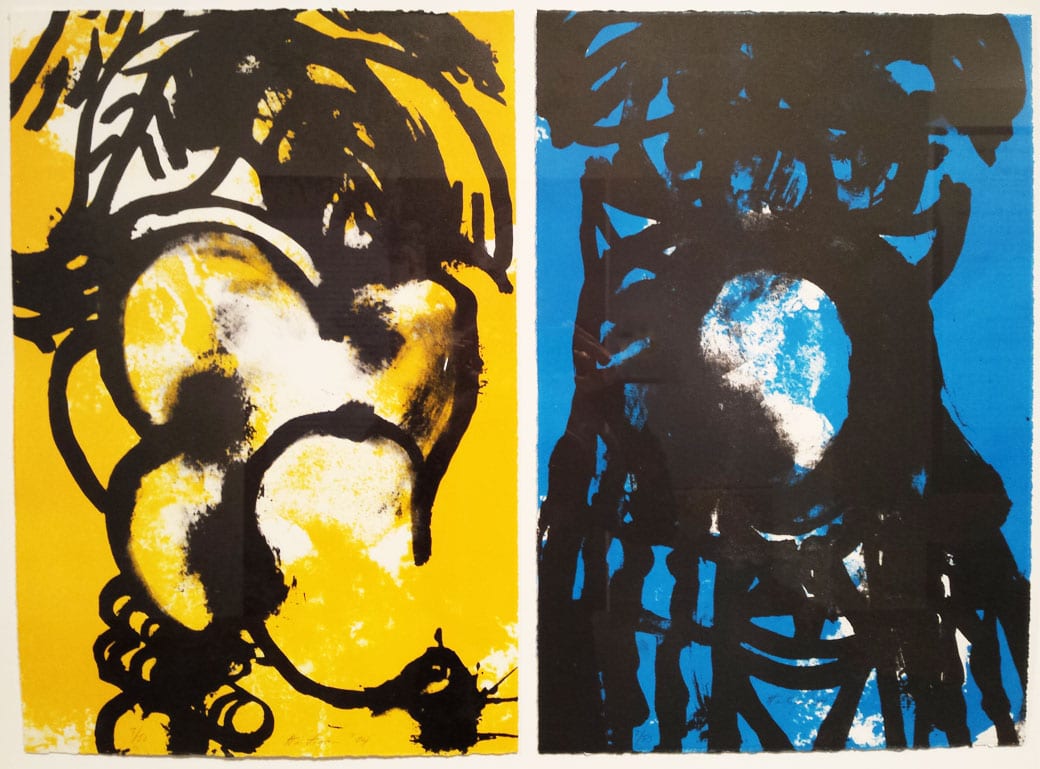The lithograph Marie Antoinette and Cleopatra is one of many prints in LUAG’s th(ink)ing exhibition located in our Main Gallery; and it’s creator Grace Hartigan is one of many interesting characters linked to the stories behind these prints.
Grace Hartigan’s strong and purposeful brush strokes mimic her bold determination to shine in the Abstract Expressionist “boy’s club” of the 1950’s in New York City. A serial lover and strong willed woman, she climbed the ranks of Manhattan art’s scene to artistic fame.
Hartigan was a Jersey Girl, born in Newark, New Jersey in 1922. At 17 her creative spirit led her and her first husband Robert Jenchens to pilgrimage to Alaska, but they only made it as far as Los Angeles, slowed down by dwindling funds and a pregnancy. In LA, with time on her hands and no where to go, Harigan took her first painting classes. Unable to continue any further in their journey, the young couple returned to New Jersey to live with Jachens’ family. Here, Hatigan began to take art courses from a local artist and soon to be lover, Isaac Lane Muse.
In 1945, Hartigan left her only son with her in-laws and moved in with Muse on the Lower East Side Manhattan. The couple quickly became part of the inner circle of the Abstract Expessionists, mingling frequently at the Cedar Tavern with the likes of Milton Avery, Mark Rothko and Adolp Gottlieb.
Leaving Muse behind, Hartigan’s second marriage was to artist Harry Jackon, but was shortly after annulled. Alone, Hartigan struggled financially on her own and found odd jobs to survive. In 1951, her art began to be more widely recognized with her first solo show at the Tibor de Nagy Gallery. Up until this time Hartigan’s work had been pure abstraction. She had once said to an interviewer “I didn’t choose painting. It chose me. I didn’t have any talent. I just had genius.” This shows how Hartigan at times recognizably lacked confidence in her talent, but with more of a following her confidence grew, and she started to incorporate recognizable imaginary from everyday life in her paintings. Because she included items from everyday life her works are classified as a precursor to Pop art, a movement that she largely disagreed with, claiming Pop art was not painting because painting “must have content and emotion.”
By 1954, Hartigan had reached official fame and could support herself completely by purely being an artist. Her work was included in MOMA’s 12 Americans exhibit in 1956. In 1958, Life Magazine called her the “most celebrated of the young American women painters” and she was the only woman artist in the exhibit TheNew American Painting which introduced European audiences to American art.
She married again in 1959 to Robert Keene, which was shortly followed in 1960 by a marriage to her fourth husband, Winston Price, who she moved with to Baltimore. She lived the rest of her days in Baltimore, where she taught at the MFA Program at the Maryland Institute College of Art and eventually became director of the Hoffberger School of Painting. She died in 2008 at the age of 86.
th(ink)ing: The Experimental Printmaking Institute at Lafayette College runs August 27 – December 7 at LUAG Main Gallery at Zoellner Arts Center, Asa Packer Campus, 420 E. Packer Ave. Bethelehem PA 18015. Gallery Hours are Wed. – Sat., 11 am – 5 pm; Sun. 1 – 5 pm.
